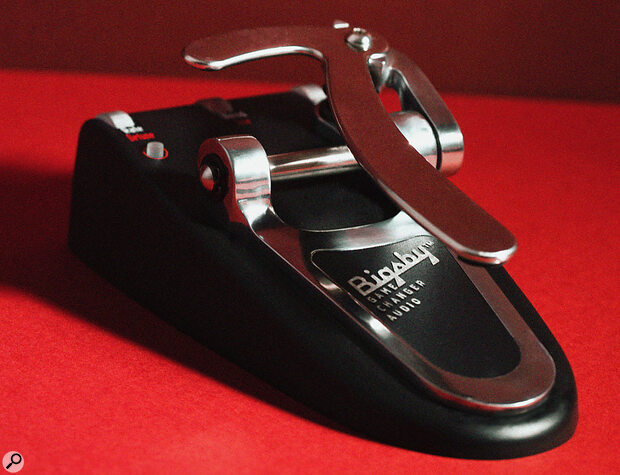There’s more to this stylish‑looking pedal than meets the eye!
Designed in collaboration with Fender, Gamechanger Audio’s Bigsby Pedal is a polyphonic pitch‑shifter that aims to achieve smooth polyphonic real‑time pitch‑shifting, while preserving the natural sound of electric and acoustic stringed instruments.
Smooth pitch‑shifting is notoriously difficult to achieve, especially on polyphonic sources, and the shifting algorithm in this pedal, which the company describe as a ‘hybrid’ and which runs on a SHARC DSP chip, does sound smoothest with smaller pitch changes — but it also sounds surprisingly good when you go for the full octave, with far less in the way of noticeable artefacts than other polyphonic pitch pedals I’ve tried.
Overview
The hardware is beautifully engineered, a specially designed arm allowing foot control in sharp and flat directions. There’s no bypass button; the pedal is always active, but a light on the top is off when the pedal is in its centre ‘no shift’ position, and glows brighter as you move from the centre, and the transition from dry to the pitch‑bent positions sounds seamless. An optical system tracks the pedal movement and a strong spring returns it to the mid position when no pressure is applied.
Three dual‑function, rotary wheel‑style controls with internal illumination address Rate Blend and downward pitch range (Depth) when their backlights show white. When the backlights are red, the controls address Detune, Tone and the upward shift range. A small button on top of the case switches modes from white to red, and a switch on the rear flips the direction in which the pedal operates, as well as being used in a routine to lock the rotary controls to prevent inadvertent adjustments.
The Detune parameter helps to emulate the mechanical imperfections of a traditional guitar vibrato arm, whereby the strings’ pitches don’t all move by exactly the same interval.
In addition to providing controlled pitch shifts of ±1 octave, in red mode the Detune parameter helps to emulate the mechanical imperfections of a traditional guitar vibrato arm, whereby the strings’ pitches don’t all move by exactly the same interval, resulting in a slight‑chorus‑like detune. When in Rate mode (white lights) the same control applies an LFO‑controlled pitch modulation that gets progressively deeper at more extreme pedal positions, its speed determined by the Rate/Detune knob position. Rate goes from a very slow undulation up to somewhere north of a fast Leslie speaker, and if you want whammy‑type fifths or octaves you’ll probably want Detune and Rate turned off. Blend/Tone mixes in some of the dry sound, producing a chorus‑like effect that gets more intense as more pitch‑shift is applied, while in red light mode it sets the tonality of the shifted signal, operating as a type of tilt EQ.
 The Bigsby isn’t just a pitch‑shifter: it can be configured as an expression controller too.
The Bigsby isn’t just a pitch‑shifter: it can be configured as an expression controller too.
A quarter‑inch TRS jack allows the pedal to be used as a sprung‑to‑centre expression controller, with adjustable depth, rate and offset parameters, and this can be used while you’re pitch shifting. Another jack accepts momentary or latching footswitches, which activate a Latch mode: a constant pitch interval is set using the Depth knob, and the pedal can make pitch changes of up to two semitones. A TRS mini‑jack MIDI input also makes it possible to control all the pedal’s parameters via CC messages. MIDI also facilitates the creating and saving of 10 presets and sync’ing the Rate’s LFO speed to subdivisions of MIDI tempo via MIDI Clock. A MIDI data chart is included, and all the settings are done using the existing controls, via the usual ‘hold this, press that’ kind of sequence. There are also details on how to get the pedal to recalibrate if anything goes wrong. In normal use, the pedal performs an auto‑calibration routine each time it powers up (so it’s important not to move the arm from its centre position when switching on; otherwise there will be a calibration error!)
Pitch Perfect?
I didn’t quite know what to expect when I first heard about the Bigsby pedal but having had my hands on one, I have to say that I’m pleasantly surprised, both by its physical construction and by its sound quality. It produces smooth pitch transitions that are at least the equal of anything else I’ve tried — and better than most. The physical aspect takes some getting used to. It’s tricky to rest your foot on the pedal between periods of pitch shifting, as it’s too easy to move it one way or the other, resulting in unwanted shifts. Also, as the pedal is longer behind the pivot point than in front of it, it’s easier to control shifts that require the long ‘arm’ to be pushed down than the short one. Once you get used to the mechanics, though, it all works extremely well, and it also offers much more ‘under the hood’ functionality than I’d expected too.
Summary
Cool and quirky, this polyphonic pitch‑shifter offers comprehensive MIDI support — and sounds great!
When you purchase via links on our site, SOS may earn an affiliate commission. More info...
When you purchase via links on our site, SOS may earn an affiliate commission. More info...


